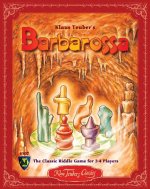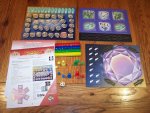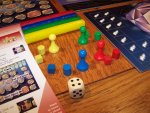
|
Barbarossa A game by Klaus Teuber Published by Catan GmbH and distributed in the US by Mayfair Games, Inc. Players: 3-4 Time: 60 minutes Reviewed by Susan Rozmiarek |

|
Barbarossa is a reworking of Klaus Teuber's classic riddle game, Barbarossa und die Rätselmeister, which won the coveted "Spiel des Jahres" or German "Game of the Year" award in 1988. It has been streamlined a bit with a few minor rules changes and transformed into a smaller physical package, but the game play remains essentially the same.
Despite the name, Barbarossa is not about the famous WWII campaign, but instead has a superficial fantasy theme and is a riddle game of guessing clay sculptures. Being more of a party game, Barbarossa is definitely a wide departure from the strategy games, such as Settlers of Catan, that Teuber is best known for. However, like most of his games, it is centered on a very clever mechanism.
Components:
Barbarossa comes in the same small-sized box as Oceania and contains the following:
- A four-page color rulebook and an insert with examples. The rules are very clearly written and we didn't find any ambiguities.
- A small game board depicting a Scoring Track and a Jewel Track
- 4 sets of wooden playing pieces in 4 different colors, each containing a pawn, a Scoring Disk and a Jewel Cube
- 1 wooden die
- 1 pad of paper
- 1 Riddle Gem tile upon which the clay sculptures will be placed
- 4 Event Tiles
- 4 bars of clay, one in each of the player colors - the clay is very bright and is not greasy at all. So far, it has held up to use and shown no signs of drying out.
- 13 arrows. These are stuck into the clay sculptures during the game and despite being heavy cardstock they have held up well.
- 12 Curse Tokens
To set up the game, the Riddle Gem tile is placed on the table with the six Event Tiles arranged around it in a circular fashion in numerical order. Player pawns are placed on the Event Tile depicting a question mark. The game board is placed nearby. The players' Scoring Disks are placed on the starting space of the Scoring Track and the players' Gem cubes are placed on the "12" space of the Jewel Track. Each player gets three Curse Tokens and the clay in his player color. The die, arrows and the pad of paper are set off to the side.
Game play:
Each player now molds items out of his clay, 3 items for a 3-player game, or 2 items for a 4-player game. A long list of possible items is provided on the insert, but players may choose anything as long as it is listed in the dictionary and it isn't an abstract idea. The goal is for players to sculpt their items so that they are somewhat difficult to guess but not too difficult. Examples of good and bad sculptures are provided on the insert. To keep everyone honest, players write down their items on a piece of paper, keeping it secret from the others until the end of the game.
The finished items or "riddles" are all placed on the Riddle Gem for players to examine. The game is now ready to start. The first player to finish sculpting his riddles begins.
On a player's turn, he rolls the die and moves his pawn that many Event Tiles clockwise and then takes the action depicted on the Event Tile. Alternatively, he may spend jewels to move to the desired Event Tile instead of rolling the die. He must decide to do this before he rolls, however. Each space moved costs one jewel and he moves his Jewel Cube on the Jewel Track accordingly to indicate how many he has spent. He now takes the action on the Event Tile. Play then passes to the player on his left.
Event Tiles and their actions
- Dragon: There are two of these tiles.
When a player lands on one all other players advance their Scoring Disks one space forward on the Scoring Track.
Note: The Ghost Tiles from the older version of the game that works similar to the Dragon except that it moves players' disks two spaces forward has been eliminated from this new edition.
- Jewel: There are also two of these tiles. When a player lands on one he moves his Jewel Cube up one space on the Jewel Track. He can only have a maximum of 13 jewels, however.
- Letter Dwarf: When a player lands on this tile, he can choose a riddle and ask its owner for a particular letter in the riddle's name. The owner writes it on a piece of paper and gives it to the player so that the information remains hidden from the other players. I found this option to be a lifesaver for me to get me started on a guess and often spent my jewels to move my pawn to this particular Event Tile.
- Question Mark:
This Event Tile is the heart of the game because it is where players can discover a lot of clues about the riddles and can make guesses.
The action for this tile has two phases. The first is the Question Phase.
The player points to a riddle and asks a question about it but without directly asking about the answer.
The owner of the riddle must answer aloud in one of the following ways:
- Yes
- Maybe
- No apparent right answer
- No
As long as the active player does not get a "no" answer he can keep asking questions about any of the riddles.
Once he gets a "no" answer he moves to the Solution Phase.
The player may continue ask questions but now he can also try to solve a riddle at any time.
However, once he gets another "no" answer, his turn ends immediately.
To try solving a riddle during the Solution Phase, the player writes down his guess on a piece of paper and gives it to the riddle's owner. If the guess is wrong, nothing happens but if it is correct, the owner of the riddle states that it is correct without revealing the answer to the other players and an arrow is stuck in the riddle. The player that guessed correctly then gets points, 5 if he is the first to solve the riddle or 3 if he is the second. The owner of the riddle may now lose or earn points and this is the clever part of the game. The number of arrows stuck in ALL the riddles is counted and compared to a chart. Without regurgitating the actual chart, with only a few arrows he loses 1 or 2 points, between 5-9 arrows he gains 1 or 2 points and after that he starts to lose them again. Four and ten arrows are the turning points where there is no effect, which is a slight tweak from the original edition. So to do well you need to try to make your riddles with just the right amount of details so that it is not guessed too early or too late.
Once a riddle has been guessed correctly twice, it is considered solved and thus can never have more than two arrows.
Curse Tokens: Players have three of these to use during the game and they are discarded once used. They can be used at any time except another player's Solution Phase to interrupt the game and allow the player to either ask for a letter as with the Letter Dwarf or to guess a riddle.
The games ends when a player reaches the finish space on the Scoring Track, or when there are 13 arrows stuck in riddles in which case the player with the most points wins.
Comments:
I must say up front that I'm not generally a fan of most party games. I prefer games that favor analytical skills rather than those that require creativity. My knowledge of trivia and pop culture is not that great, I'm poor at drawing and I don't like to perform charades-style in front of a group. Fortunately, Barbarossa forces me to do none of those and so belongs to a small group of party games that I am willing to play on occasion. I enjoyed the sculpting part of Barbarossa given that one does not have to be skilled at sculpting details to do well. Unfortunately, I am not as skilled at guessing sculptures, but having the option of asking for particular letters in the solution helps greatly. Some of the others that I played with were quite good at the guessing part and really enjoyed the challenge. All of my games were quite lively and fun, even if I did get a little frustrated at times.
I'm not entirely enamored with the roll-and-move mechanism for determining turn actions and the jewel system seems bit fussy. I also didn't care for the Dragon Event Tiles although I suppose their possibility creates a bit of angst over whether or not to spend jewels. This all seems to just be a distraction from the really enjoyable part of figuring out the riddles although the kids who played seemed to like it. I also wish the game handled more than four players. I believe the old edition could be played with up to six.
Fans of party games requiring creativity will probably really enjoy Barbarossa. The idea of rewarding sculptures that are ambiguous but not overly so is a very clever twist and makes the game quite fun, even for players like me. Although due to my personal preferences it will never be a favorite of mine, Barbarossa is definitely one of the better games of this type that I've played.
| Other Web information: |
This page viewed
E-mail Ed Rozmiarek with questions or problems concerning this page.
Copyright © 2006, Ed & Susan Rozmiarek. No portion of this website may be reproduced or copied without the consent of Ed or Susan Rozmiarek.


